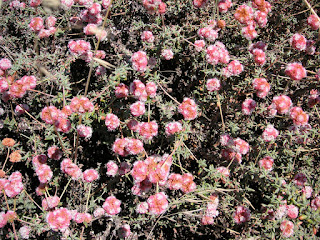I can't tell you how many times I've walked past this and wondered what it was. The pink pom-pom flowers are whimsical. Often it's buzzing with visiting bees and flies. Considering there are 266 records of Eriogonum in Calflora, I'm making my best guess as to species. What struck me for ID were the narrow leaves and bush-like appearance. It's along the Rec Trail, but I'm including this post under Stanford's Hopkins Marine Station for location 'x.' The reason being is that there's a section of the trail in front of Hopkins that looks to me like someone, many years ago, decided to plant various CA natives, even ones that would not necessarily be naturally found in this spot. Those tall smoke stacks in the upper right of the last photo are fake; they're part of Monterey Bay Aquarium's nod to its historical cannery location.
ps 03/29/13 - Evan Moor Educational Publishers contacted me for use of these three photos above in a unit that talks about the El Segundo blue butterfly. I declined their permissions request, and I gave the following explanation for my refusal:
"While I'd love to get a little extra cash for my photographs, I'm afraid I cannot let you use mine for the purposes of illustrating the El Segundo blue. I'm a stickler for accuracy on websites and educational materials.
Here's why my specific photographs will not be appropriate for your use:
1) I state in my blog post that I was making a best guess as to species.
2) Even if my pictures are indeed the specific Eriogonum out of a possible 250+!!! found in CA, I've seen variations in plants depending on location. My Rec Trail ones may indeed look different than those found near the LA airport sites, but I can't be sure since I've not been down there.
3) The El Segundo blue has an extremely short flight period when the sea cliff buckwheat is in peak bloom in June. My pictures were taken August 1 long after the flowers have aged to deep bright pink. By August I suspect this blue butterfly is in the late caterpillar instar stages.
My suggestions to you is find photographs actually from SoCal, preferably taken on the same day as ones with the El Segundo blue butterfly in them, such as http://sittingknitting.blogspot.com/2008/06/el-segundo-blue.html. Or if you'd like, I could ask some of my CNPS contacts for pictures. I used to be an entomologist, a science content editor, and a rights and permissions coordinator, so I feel for you as you search for publishable photographs."
ps 03/29/13 - Evan Moor Educational Publishers contacted me for use of these three photos above in a unit that talks about the El Segundo blue butterfly. I declined their permissions request, and I gave the following explanation for my refusal:
"While I'd love to get a little extra cash for my photographs, I'm afraid I cannot let you use mine for the purposes of illustrating the El Segundo blue. I'm a stickler for accuracy on websites and educational materials.
Here's why my specific photographs will not be appropriate for your use:
1) I state in my blog post that I was making a best guess as to species.
2) Even if my pictures are indeed the specific Eriogonum out of a possible 250+!!! found in CA, I've seen variations in plants depending on location. My Rec Trail ones may indeed look different than those found near the LA airport sites, but I can't be sure since I've not been down there.
3) The El Segundo blue has an extremely short flight period when the sea cliff buckwheat is in peak bloom in June. My pictures were taken August 1 long after the flowers have aged to deep bright pink. By August I suspect this blue butterfly is in the late caterpillar instar stages.
My suggestions to you is find photographs actually from SoCal, preferably taken on the same day as ones with the El Segundo blue butterfly in them, such as http://sittingknitting.blogspot.com/2008/06/el-segundo-blue.html. Or if you'd like, I could ask some of my CNPS contacts for pictures. I used to be an entomologist, a science content editor, and a rights and permissions coordinator, so I feel for you as you search for publishable photographs."



No comments:
Post a Comment